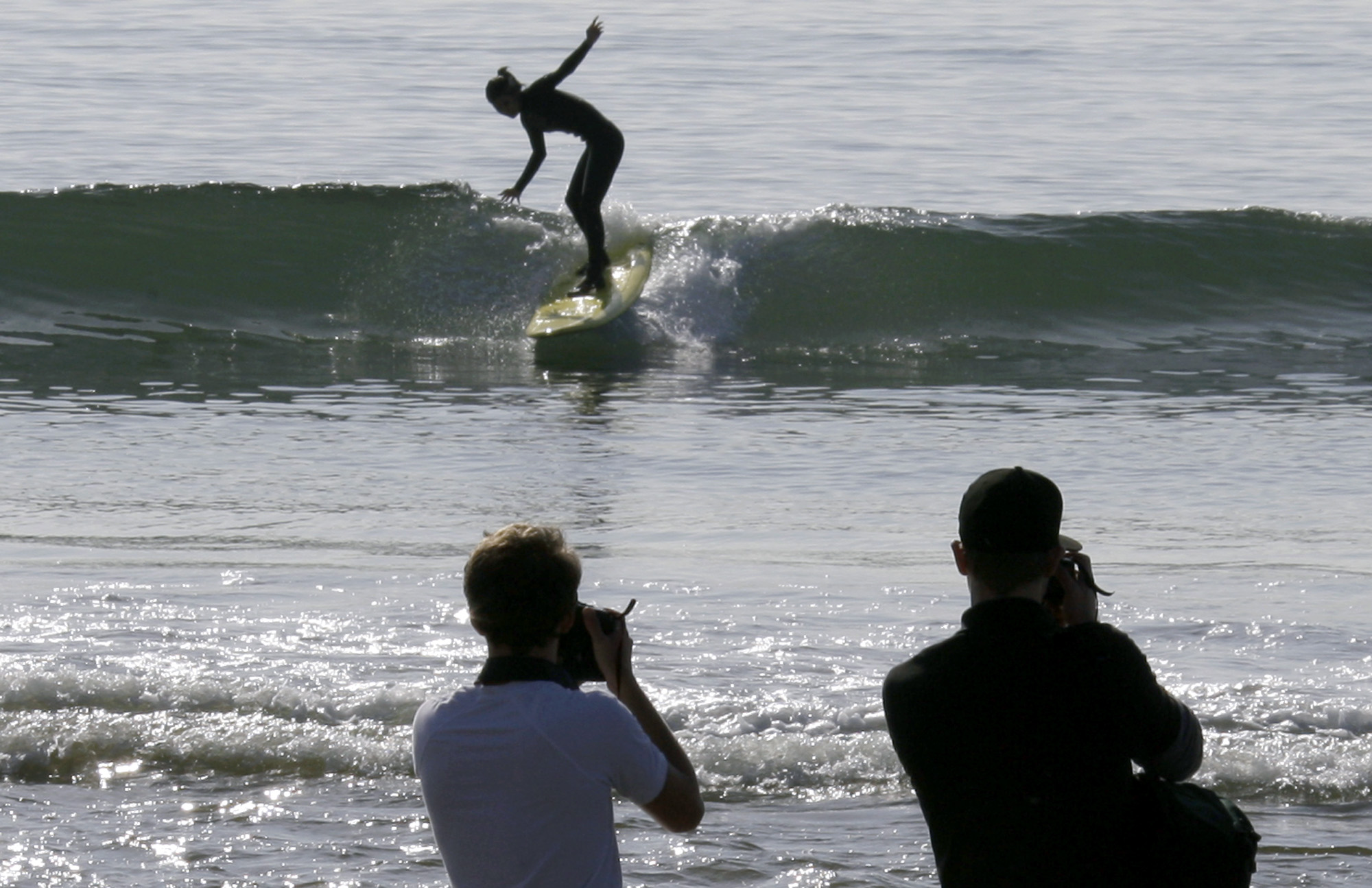 Visitors take photos as a surfer takes a wave at about the time the effects of a tsunami were expected, at Surfrider Beach in Malibu, Calif., Friday, March 11, 2011. Though waves surged in other areas along California's coast from a tsunami triggered by the massive earthquake in Japan, there was little noticeable change in conditions at Malibu, where the beach was not closed to the public. (AP Photo/Reed Saxon).
Visitors take photos as a surfer takes a wave at about the time the effects of a tsunami were expected, at Surfrider Beach in Malibu, Calif., Friday, March 11, 2011. Though waves surged in other areas along California's coast from a tsunami triggered by the massive earthquake in Japan, there was little noticeable change in conditions at Malibu, where the beach was not closed to the public. (AP Photo/Reed Saxon).CHRISTINA HOAG, Associated Press
NOAKI SCHWARTZ, Associated Press
LOS ANGELES - A tsunami surge from Japan's magnitude-8.9 earthquake swept along the southern half of California on Friday, rocking boats, turning harbor waters brown and drawing sight-seers but causing little apparent damage.
At Morro Bay on the San Luis Obispo County coast, hundreds of people were evacuated from low-lying areas, the harbor and embarcadero out of concern, said police Chaplain James Berg. Swells knocked some boats loose and damaged a dock when the initial surge arrived, he said. Evacuees were sent to a veterans building and a supermarket parking lot.
Spectators gathered along vantage points along the coast from Malibu to San Diego, hoping to see the phenomenon.
U.S. Geological Survey seismologist Lucy Jones warned that a tsunami does not just come and go as one surge, and the sloshing would continue into the afternoon.
"There's a lot of force pushing that water down the Pacific," Jones, chief scientist of the USGS Multi-Hazards Demonstration Project, told a press conference at the California Institute of Technology in Pasadena.
Damage was reported along the Northern California coast but there were no such reports from Southern California, she said at midmorning.
Some cities in Los Angeles and Orange Counties closed beaches and piers. An elementary school on the Newport Beach peninsula was closed for the day. Authorities ordered surfers out of the water at Los Angeles' Venice Beach.
At Ventura Harbor northwest of Los Angeles, the first surge arrived at 8:52 a.m. and there was a 2-foot rise that retreated eight minutes later, said Harbor Master Scott Miller.
There was no damage but the harbor's brilliant blue water turned brown.
"It went from being very clear, clean water to very muddy water," Miller said.
As the water receded and quieted, the silt settled back to the bottom and the water started regaining its color, he said.
The twin ports of Los Angeles and Long Beach remained in operation for cargo shipments, but loading and unloading of petroleum was halted, said Los Angeles Fire Department spokesman Ronnie R. Villanueva at a port command center.
"Other than that, it's business as usual," Villanueva said.
In Santa Barbara, some boaters moved their vessels out of the local harbor and into deeper waters offshore, but others were taking the tsunami in stride.
"I'm just going to monitor it and see how it goes," said Charlie Graham, a commercial lobster fisherman.
Sheri Shrout said she told her husband, also a fisherman, not to go to work but he said "I'm safer out there than in the harbor."
The water rose 3 feet in eight minutes at King Harbor in Redondo Beach and then quickly fell, but there was no damage to docks or boats, said Cameron G. Thomas, a marina dock master. The surge didn't flush away thousands of reeking sardines that have fouled the harbor all week since a huge school became stuck in one of the marinas and apparently suffocated when they depleted the oxygen in the water.
There were also no reports of damage at San Diego, where the tsunami's arrival was barely noticeable.
The water level at San Diego's Mission Bay subtly dropped about 3 feet around 9:15 a.m., followed by an influx of water, said Maurice Luque, spokesman for the San Diego Fire-Rescue Department
The tide appeared to recede about 25 yards at about the same time in La Jolla, where a message read periodically over a lifeguard tower loud speaker reminded swimmers of the tsunami advisory and a police officer distributed flyers urging people to stay out of the water.
Most heeded the advice.
"I don't want to be the idiot who was warned," said Paul Ho, 33, a surfer who waited out the tsunami's arrival.
About 100 people were on the beach expecting a spectacle, but many left before the water began to recede.
Federal regulators, meanwhile, said California's Diablo Canyon and San Onofre nuclear power plants were operating normally and were being monitored by inspectors during the West Coast tsunami threat.
Nuclear Regulatory Commission spokesman Neil Sheehan said Diablo Canyon declared an "unusual event," the lowest of four levels of emergency classification and employees took pre-planned actions due to the tsunami threat.
While the tsunami had little significant effect on Southern California, the huge earthquake that triggered it did cause more than a dozen cancellations of flights between Japan and Los Angeles International Airport.
Dozens of people waited in lines to get information about the rescheduled departure of a Singapore-bound Singapore Airlines flight that was supposed to stop in Tokyo. Among them was an Indonesian family.
"I've experienced pretty bad earthquakes, so I know how the Japanese people are feeling," said Yanti Herwan. "It's better that the flight is cancelled so that everybody can be safe."
But a Japanese businessman, Fujii Yoshimi, was anxious to get home to his wife and a son who live outside Tokyo.
"The last 24 hours has been very sad," Yoshimi said, adding that his family felt the shaking but was unharmed. "I feel very lucky that nothing severe happened to them. But I am very sad for my country."
